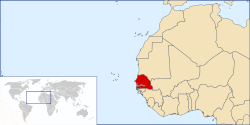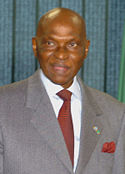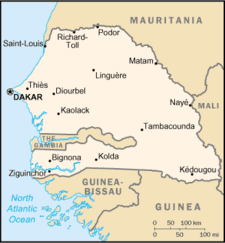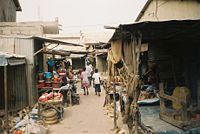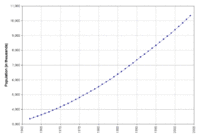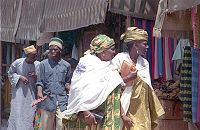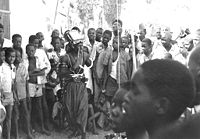Senegal
2008/9 Schools Wikipedia Selection. Related subjects: Africa; African Countries
| République du Sénégal Republic of Senegal
|
||||||
|---|---|---|---|---|---|---|
|
||||||
| Motto: "Un Peuple, Un But, Une Foi" (French) "One People, One Goal, One Faith" |
||||||
| Anthem: Pincez Tous vos Koras, Frappez les Balafons |
||||||
|
|
||||||
| Capital (and largest city) |
Dakar |
|||||
| Official languages | French | |||||
| Recognised regional languages | Wolof (spoken by 94 percent) | |||||
| Demonym | Senegalese | |||||
| Government | Semi-presidential republic | |||||
| - | President | Abdoulaye Wade | ||||
| - | Prime Minister | Cheikh Hadjibou Soumaré | ||||
| Independence | ||||||
| - | from France | 20 August 1960 | ||||
| Area | ||||||
| - | Total | 196,723 km² ( 87th) 76,000 sq mi |
||||
| - | Water (%) | 2.1 | ||||
| Population | ||||||
| - | 2005 estimate | 11,658,000 ( 72nd) | ||||
| - | Density | 59/km² ( 137th) 153/sq mi |
||||
| GDP ( PPP) | 2005 estimate | |||||
| - | Total | $20.504 billion ( 109th) | ||||
| - | Per capita | $1,759 ( 149th) | ||||
| Gini (1995) | 41.3 (medium) | |||||
| HDI (2007) | ▲ 0.499 (low) ( 156th) | |||||
| Currency | CFA franc ( XOF) |
|||||
| Time zone | UTC | |||||
| Internet TLD | .sn | |||||
| Calling code | +221 | |||||
Senegal (French: le Sénégal), officially the Republic of Senegal, is a country south of the Sénégal River in western Africa. Senegal is bounded by the Atlantic Ocean to the west, Mauritania to the north, Mali to the east, and Guinea and Guinea-Bissau to the south. The Gambia lies almost entirely within Senegal, surrounded on the north, east and south; from its western coast, Gambia's territory follows the Gambia River more than 300 kilometres (186 miles) inland. Dakar is the capital city of Senegal, located on the Cape Verde Peninsula on the country's Atlantic coast.
History
Archaeological findings throughout the area indicate that Senegal was inhabited in prehistoric times.
Eastern Senegal was once part of the Empire of Ghana. It was founded by the Tukulor in the middle valley of the Senegal River. Islam, the dominant religion in Senegal, first came to the region in the 11th century. In the 13th and 14th centuries, the area came under the influence of the Mandingo empires to the east; the Jolof Empire of Senegal also was founded during this time.
Various European powers—Portugal, the Netherlands, and Great Britain—competed for trade in the area from the 15th century onward, until in 1677, France ended up in possession of what had become an important slave trade departure point—the infamous island of Gorée next to modern Dakar. Millions of West African people were shipped from here. It was only in the 1850s that the French began to expand their foothold onto the Senegalese mainland, at the expense of native kingdoms such as Waalo, Cayor, Baol, and Jolof.
In January 1959 Senegal and the French Sudan merged to form the Mali Federation, which became fully independent on June 20, 1960, as a result of the independence and the transfer of power agreement signed with France on April 4, 1960. Due to internal political difficulties, the Federation broke up on August 20. Senegal and Sudan (renamed the Republic of Mali) proclaimed independence. Léopold Senghor was elected Senegal's first president in September 1960.
After the breakup of the Mali Federation, President Senghor and Prime Minister Mamadou Dia governed together under a parliamentary system. In December 1962 their political rivalry led to an attempted coup by Prime Minister Dia. Although this was put down without bloodshed, Dia was arrested and imprisoned, and Senegal adopted a new constitution that consolidated the president's power. In 1980 President Senghor decided to retire from politics, and he handed power over in 1981 to his handpicked successor, Abdou Diouf.
Senegal joined with The Gambia to form the nominal confederation of Senegambia on February 1 1982. However, the union was dissolved in 1989. Despite peace talks, a southern separatist group in the Casamance region has clashed sporadically with government forces since 1982. Senegal has a long history of participating in international peacekeeping.
Abdou Diouf was president between 1981 and 2000. He encouraged broader political participation, reduced government involvement in the economy, and widened Senegal's diplomatic engagements, particularly with other developing nations. Domestic politics on occasion spilled over into street violence, border tensions, and a violent separatist movement in the southern region of the Casamance. Nevertheless, Senegal's commitment to democracy and human rights strengthened. Diouf served four terms as president.
In the presidential election of 2000, opposition leader Abdoulaye Wade defeated Diouf in an election deemed free and fair by international observers. Senegal experienced its second peaceful transition of power, and its first from one political party to another. On December 30, 2004 President Abdoulaye Wade announced that he would sign a peace treaty with the separatist group in the Casamance region. This, however, has yet to be implemented. There was a round of talks in 2005, but the results did not yet yield a resolution.
Politics
Senegal is a republic with a powerful presidency; the president is elected every seven years, amended in 2001 to every five years, by universal adult suffrage. The current president is Abdoulaye Wade, re-elected in March 2007.
Senegal has more than 80 political parties. The unicameral National Assembly has 120 members elected separately from the president. An independent judiciary also exists in Senegal. The nation's highest courts that deal with business issues are the constitutional council and the court of justice, members of which are named by the president.
Today Senegal has a democratic political culture, being one of the more successful post-colonial democratic transitions in Africa. Local administrators are appointed by, and responsible to, the president. The marabouts, religious leaders of the various Senegalese Muslim brotherhoods, also exercise a strong political influence in the country, most notably the leader of the Mouride brotherhood, Serigne Mouhamadou Lamine Bara Mbacke.
Geography
Senegal is located on the west of the African continent. The Senegalese landscape consists mainly of the rolling sandy plains of the western Sahel which rise to foothills in the southeast. Here is also found Senegal's highest point, an otherwise unnamed feature near Nepen Diakha at 584 m (1926 ft). The northern border is formed by the Senegal River, other rivers include the Gambia and Casamance Rivers. The capital Dakar lies on the Cap-Vert peninsula, the westernmost point of continental Africa.
The local climate is tropical with well-defined dry and humid seasons that result from northeast winter winds and southwest summer winds. Dakar's annual rainfall of about 600 mm (24 in) occurs between June and October when maximum temperatures average 27 °C (81 °F); December to February minimum temperatures are about 17 °C (63°F). Interior temperatures can be substantially higher than along the coast, and rainfall increases substantially farther south, exceeding 1.5 m (59.1 in) annually in some areas. The far interior of the country, in the region of Tambacounda, particularly on the border or Mali, temperatures can reach as high as 130 °F (54 °C).
The Cape Verde islands lie some 560 kilometers (348 mi) off the Senegalese coast, but Cap Vert ("Cape Green") is a maritime placemark, set at the foot of "Les Mammelles" , a 105-metre (344 ft) cliff resting at one end of the Cap Vert peninsula onto which is settled Senegal's capital Dakar, and 1 kilometre (1,100 yd) south of the "Pointe des Almadies", the western-most point in Africa.
Population of major cities
| City | Population |
|---|---|
| Dakar | 1,998,635 |
| Touba | 428,059 |
| Thiès | 240,152 |
| Rufisque | 187,203 |
| Saint-Louis | 178,782 |
| Kaolack | 173,782 |
| M'Bour | 170,699 |
| Ziguinchor | 130,750 |
Regions, departments, and arrondissements
Senegal is subdivided into 11 regions, each administered by a Conseil Régional ( Regional Council) elected by population weight at the Arrondissement level. The country is further subdivided by 34 Départements, 103 Arrondissements (neither of which have administrative function) and by Collectivités Locales, which elect administrative officers.
Regional capitals have the same name as their respective regions:
|
|
|
Economy
In January 1994 Senegal undertook a bold and ambitious economic reform programme with the support of the international donor community. This reform began with a 50 percent devaluation of Senegal's currency, the CFA franc, which was linked at a fixed rate to the former French franc and now to the euro. Government price controls and subsidies have been steadily dismantled. After seeing its economy retract by 2.1 percent in 1993, Senegal made an important turnaround, thanks to the reform programme, with real growth in GDP averaging 5 percent annually during the years 1995–2001. Annual inflation was reduced to less than 1 percent, but rose again to an estimated 3.3 percent in 2001. Investment increased steadily from 13.8 percent of GDP in 1993 to 16.5 percent in 1997.
The main industries include food processing, mining, cement, artificial fertilizer, chemicals, textiles, refining imported petroleum, and tourism. Exports include fish, chemicals, cotton, fabrics, groundnuts, and calcium phosphate, and the principal foreign market is India at 26.7 percent of exports (as of 1998). Other foreign markets include the US, Italy, and the UK.
As a member of the West African Economic and Monetary Union (WAEMU), Senegal is working toward greater regional integration with a unified external tariff. Senegal also realized full Internet connectivity in 1996, creating a mini-boom in information technology-based services. Private activity now accounts for 82 percent of GDP. On the negative side, Senegal faces deep-seated urban problems of chronic unemployment, socioeconomic disparity, juvenile delinquency, and drug addiction.
Demographics
Senegal has a population of over 11 million, about 70 percent of whom live in rural areas. Density in these areas varies from about 77 inhabitants per square kilometre (199/sq mi) in the west-central region to 2 inhabitants per square kilometre (5/sq mi) in the arid eastern section. According to the World Refugee Survey 2008, published by the U.S. Committee for Refugees and Immigrants, Senegal has a population of refugees and asylum seekers numbering approximately 23,800 in 2007. The majority of this population (20,200) is from Mauritania. Refugees live in N'dioum, Dodel, and small settlements along the Senegal River valley.
Ethnicity
Senegal has a wide variety of ethnic groups and, as in most West African countries, several languages are widely spoken. The Wolof are the largest single ethnic group in Senegal at 43 percent; the Peul and Toucouleur (also known as Halpulaar, Fulbe or Fula) (24 percent) are the second biggest group, followed by others that include the Serer (15 percent), Lebou (10 percent), Jola (4 percent), Mandinka (3 percent), Maures or Naarkajors, Soninke, Bassari and many smaller communities (9 percent). (See also the Bedick ethnic group.) About 50,000 Europeans (1 percent) (mostly French) as well as smaller numbers of Mauritanians and Lebanese reside in Senegal, mainly in the cities. Also located primarily in urban settings are the minority Vietnamese communities. From the time of earliest contact between Europeans and Africans along the coast of Senegal, particularly after the establishment of coastal trading posts during the fifteenth century, communities of mixed African and European (mostly French and Portuguese) origin have thrived. Cape Verdeans living in urban areas and in the Casamance region represent another recognized community of mixed African and European background. French is the official language, used regularly by a minority of Senegalese educated in a system styled upon the colonial-era schools of French origin (Koranic schools are even more popular, but Arabic is not widely spoken outside of this context of recitation). Most people also speak their own ethnic language while, especially in Dakar, Wolof is the lingua franca. Pulaar is spoken by the Peuls and Toucouleur. Portuguese Creole is a prominent minority language in Ziguinchor, regional capital of the Casamance, where some residents speak Kriol, primarily spoken in Guinea-Bissau. Cape Verdeans speak their native creole, Cape Verdean Creole, and standard Portuguese.
Religion
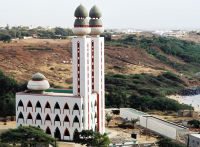
Islam is the predominant religion, practiced by approximately 95 percent of the country's population; the Christian community, at 4 percent of the population, includes Roman Catholics and diverse Protestant denominations. There is also a 1 percent population who maintain animism in their beliefs, particularly in the southeastern region of the country.
Islam
Islamic communities are generally organized around one of several Islamic Sufi orders or brotherhoods, headed by a khalif (xaliifa in Wolof, from Arabic khalīfa), who is usually a direct descendant of the group’s founder. The two largest and most prominent Sufi orders in Senegal are the Tijaniyya, whose largest sub-groups are based in the cities of Tivaouane and Kaolack, and the Murīdiyya (Murid), based in the city of Touba. The Halpulaar, a widespread ethnic group found along the Sahel from Chad to Senegal, representing 20 percent of the Senegalese population, were the first to be converted to Islam. The Halpulaar, composed of various Fula people groups, named Peuls and Toucouleurs in Senegal. Many of the Toucouleurs, or sedentary Halpulaar of the Senegal River Valley in the north, converted to Islam around a millennium ago and later contributed to Islam's propagation throughout Senegal. Most communities south of the Senegal River Valley, however, were not thoroughly Islamized until the nineteenth and early twentieth centuries. During the mid-19th century, Islam became a banner of resistance against the traditional aristocracies and French colonialism, and Tijānī leaders Al-Hajj Umar Tall and Màbba Jaxu Ba established short-lived but influential Islamic states but were both killed in battle and their empires than annexed by the French.
The spread of formal Quranic school (called daara in Wolof) during the colonial period increased largely through the effort of the Tijaniyya. In Murid communities, which place more emphasis on the work ethic than on literary Quranic studies, the term daara often applies to work groups devoted to working for a religious leader. Other Islamic groups include the much older Qādiriyya order and the Senegalese Laayeen order, which is prominent among the coastal Lebu. Today, most Senegalese children study at daaras for several years, memorizing as much of the Qur'an as they can. Some of them continue their religious studies at informal Arabic schools (majlis) or at the growing number of private Arabic schools and publicly funded Franco-Arabic schools.
Christianity
Small Roman Catholic communities are mainly found in coastal Serer, Jola, Mankanya and Balant populations, and in eastern Senegal among the Bassari and Coniagui. In Dakar Catholic and Protestant rites are practiced by the Lebanese, Capeverdian, European, and American immigrant population, and among certain Africans of other countries. Although Islam is Senegal's majority
Other religions
Animism is the other main religion practiced. There are also small numbers of adherents of Judaism and Buddhism. Judaism is followed by members of several ethnic groups, while Buddhism is followed by a number of Vietnamese.


